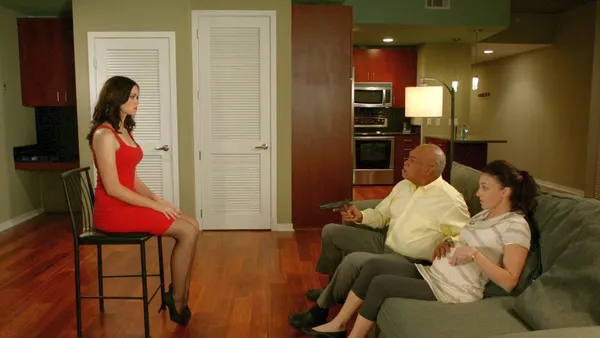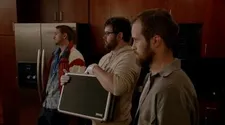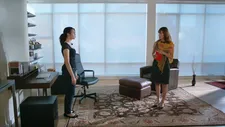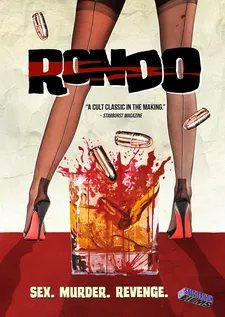 |
| The stage is set for shocking events in Rondo |
In 1961, posters for Roger Corman's Edgar Allen Poe adaptation The Pit And The Pendulum promised to pay £10,000 to the family of the first audience member who died of fright. Drew Barnhardt's Rondo takes a similar approach with a poster warning viewers that what they are about to see may shock them beyond human endurance. It's weird, it's wild! the posters warn. It features sex, murder and revenge. Well, what's not to like?
Of course, it’s a difficult thing to shock audiences in this day and age. When Drew agreed to answer some questions about the film, I began by asking him if this approach was primarily a stylistic thing or was he seriously trying to shock. Does he think, based on reactions so far, that he got away with it?
 |
| Do you know what you're letting yourself in for? |
"It’s funny," he responds. "I never really found anything in the movie 'shocking'. To me it was all just amusing. I guess that’s a bit of the movie-prankster impulse coming out. I relished the opportunity to use a few cinematic tricks from some of my favourite movies to keep the audience on their toes (and to entertain myself in the process).
"Since it was going to be a low budget affair I knew that the storyline had better keep people interested. Sex. Violence. Twists. Humour. So that was how I approached it; try to keep the audience engaged. If some are shocked then great! If not, then I hope they get a chuckle out of it."
Of all the recent films about soldiers trying to readjust to society after returning home, this is probably the strangest. How did the story idea originally develop?
"As often happens in the low budget indie world, at least for me, is that the storyline is born from your limitations and the (precious few) resources you find available to you. In this case, the locations were what we had, so it was up to me to tailor a storyline and a script to fit those locations.
"To begin the movie almost in the space of melodrama, with a soldier having returned home with PTSD, grounds the picture early on in a sober reality. Then, with that foundation, the movie can build up into the realm of absurdity. I always felt that the movie played out as if we were slowly, but constantly, turning up the volume dial on the absurdity. From one to eleven."
Telling this story effectively requires a highly stylised kind of acting. How did Drew go about casting it and making sure that everybody understood what they needed to deliver?
"This can be a tricky thing. I enjoy stylised acting more than the strictly naturalistic approach. I am a fan of both the stylised underplayed, dry approach that you see in David Mamet’s films as well as the Mega-Acting you see in things like The Shining or Scarface, for example. In finding a balance I always try to let the sense of humour guide me, as I do in most choices. When your aim of a scene is to present the villains as the most evil characters possible, you have some leeway to go big. For the most part though, I lean towards the dry approach to performance that will compliment the dry approach to the humour in the writing. This also extends to motion; I am a big proponent of stillness in performance, especially when it comes to creating suspense."
 |
| One shot too many? |
Some viewers are always unhappy about films with a significant focus on sexual violence against women, but this film also features men as victims and has two formidable female characters. Did these issues concern him when he was developing it?
"I can both understand and absolutely appreciate the inherent discomfort with such material," he says. "But as you said, the female characters are at the heart of this movie. Frankly, I was much more invested in empowering the female characters (both the good and the bad) than in any others. Plus, I like to think that both the men and women of Rondo are treated with equal generosity when it comes to wickedness.
"The other element of this, and though it’s an interview cliché I would be disingenuous not to add, is that Rondo is as much about a specific genre, and a transgressive one at that, as it is about anything else. The lurid, the bloody, the sexy and the thoroughly upsetting are all part of this genre’s cinematic grammar and I certainly wanted to focus hard on all of them, albeit with my tongue firmly in cheek."
The very sleek way this film is put together suggests that a lot of time was taken to get each shot just right. Was that the case?
"Conceiving the visual design of the picture is probably the thing which gets me the most excited. The question of every shot is 'Why is the camera there?' It could be anywhere, so how is your camera servicing the story? Visual specificity, and lack of visual waste, is of utmost importance to me.
 |
| In line for trouble |
"At one level it is an absolute necessity when you’re dealing with a low budget: you have to be specific about what you want the audience to see, when and where you want them to see it, and why.
"You don’t have the time to shoot a scene from every conceivable angle ‘just in case.’ This sounds like a limitation, but it is absolutely what gets me the most excited about making a movie. I love the idea of: 'If the camera is here it could be very suspenseful... If the camera is here it could heighten the humour... And, hopefully, 'if the camera is here we can do both.'
"Now, in a low budget flick like this, these are decisions that must be made before you get on the set, and it is in this planning stage where I feel the most joy and fun about making a movie. Sorry, I get excited just thinking about it."
The sets in the film are beautifully put together and recall Seventies exploitation classics at the same time as leaving a lot of room for the actors and the camera to move around. How did he go about assembling all this?
"To be honest, we didn’t have it in our budget for a production designer or an art director so it all came down to selecting and subtracting. Sometimes you can get as much or more by removing things than by adding them. That was our low-budget philosophy which, ultimately, resulted in a fairly stripped down look where there aren’t many things in the frame to distract you from the action or the business at hand. Then when you add something into the frame, it takes on greater significance. It’s admittedly a very low-fi approach to production design, but we worked with what we had."
 |
| Looking for the truth |
Music is a very important contributor to the mood in the film. Did he know the sort of thing he needed at the outset or was it all developed after shooting?
"Obviously the music is a big deal to me and this picture is very densely scored. Ryan Franks and Scott Nickoley are the composers (and sound designers). Ryan and I went to high school together way back when and he has composed the music to just about everything I’ve done since. We always get into some heavy musical deep dives on each new project.
"In the past I have used a lot of very specific temp tracks that were references in and of themselves so it was necessary for Ryan to stick more closely to them. On Rondo, I wasn’t nearly as specific. I had temp tracked the whole movie with classical waltzes and, as you’ve seen the movie, you realise that is not at all what we arrived at. Ryan has a very unique sound all of his own and because of that I can write music cues into the script because I know what he can do and I can have faith and total confidence in his music driving a moment or even commenting on it."
Is it fair to say that he used the promise of cheap thrills to seduce his audience into watching something they’d avoid if it was presented as art?
 |
| DVD cover art for Rondo |
"I think it is fair to say that," he responds. "However I don’t feel I arrive at that approach from a dishonest place. I happen to enjoy cheap thrills as much as anyone. Stylistically speaking, I also believe that an additional type of tension or suspense can be created just by the very juxtaposition of these extremes. Many of my favourite films exist in that space; in that stylistic tug of war, where you really can’t be sure what to expect next. This is a dynamic that I’ve always been interested in and entertained by. These types of films can be challenging, interesting and amusing. Those are three of my favourite qualities in any flick. I think that both exploitation hounds as well as art snobs will be able to enjoy this. I think this because I am both.
How does he feel about the way the film has been received at festivals?
"I was thrilled," he says. "Producer Guy Clark and I knew going into this that this movie was not going to be for everyone, we just hoped that it might be for someone. We knew that we liked it, so we focused on making it for folks like ourselves: handsome, witty and charming.
"We always figured it would be a 50-50 love-it-or-hate-it proposition. What we didn’t want was anybody to be ambivalent about the movie. Frankly I’m just as amused by the hate as the love.
"At Fantasia I felt we had the perfect audience. If you’re showing a genre, strange, or a challenging flick, there is no better, more enthusiastic and cinema literate audience in the world than you will find at Fantasia.
"It was a thrill for me and if Rondo could talk I’m sure she would say the same."
So what will he be working on next?
"Well, I plan to keep raging on like some sort of insipid sub-genre locust. I’m working on something new right now that I can’t talk too much about except to say that it is operating in another familiar sub-genre that I’m trying to smear my sense of humour all over. Hopefully it will be darker, funnier and more twisted than Rondo. Fingers crossed."
Rondo will be available to buy on DVD from 4 June.





















